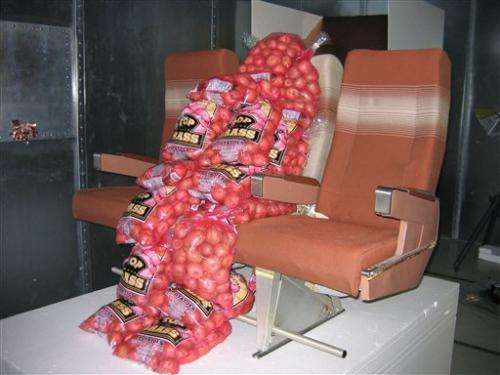Boeing engineers use spuds to improve in-air Wi-Fi

If the wireless Internet connection during your holiday flight seems more reliable than it used to, you could have the humble potato to thank.
While major airlines offer in-flight Wi-Fi on many flights, the signal strength can be spotty. Airlines and aircraft makers have been striving to improve this with the growing use of wireless devices and the number of people who don't want to be disconnected, even 35,000 feet (10,700 meters) up.
Engineers at Chicago-based Boeing Co. used sacks of potatoes as stand-ins for passengers as they worked to eliminate weak spots in in-flight wireless signals. They needed full planes to get accurate results during signal testing, but they couldn't ask people to sit motionless for days while data was gathered.
"That's where potatoes come into the picture," Boeing spokesman Adam Tischler said.
It turns out that potatoes—because of their water content and chemistry—absorb and reflect radio wave signals much the same way as the human body does, making them suitable substitutes for airline passengers.
"It's a testament to the ingenuity of these engineers. They didn't go in with potatoes as the plan," Tischler said.
Recapping the serendipitous path that led to better onboard wireless, Tischler said a member of the research team stumbled across an article in the Journal of Food Science describing research in which 15 vegetables and fruits were evaluated for their dielectric properties, or the way they transmit electric force without conduction.
Its conclusions led the Boeing researchers to wonder if potatoes might serve just as well as humans during their own signal testing. Despite some skepticism, they ended up buying 20,000 pounds (9,000 kilograms) of them.
Video and photos of the work, which started in 2006, show a decommissioned airplane loaded with row upon row of potato sacks that look like large, lumpy passengers. The sacks sit eerily still in the seats as the engineers collect data on the strength of wireless signals in various spots.
The Boeing engineers added some complicated statistical analysis and the result was a proprietary system for fine tuning Internet signals so they would be strong and reliable wherever a laptop was used on a plane.
Boeing says the system also ensures Wi-Fi signals won't interfere with the plane's sensitive navigation and communications equipment.
"From a safety standpoint, you want to know what the peak signals are, what's the strongest signal one of our communications and navigation systems might see from a laptop or 150 laptops or 350 laptops," Boeing engineer Dennis Lewis explains in a video.
In a nod to the humor in using a tuber to solve a high-tech problem, researchers dubbed the project Synthetic Personnel Using Dialectic Substitution, or SPUDS.
The company says better Wi-Fi signals can be found already on three Boeing aircraft models flown by major airlines: 777, 747-8 and the 787 Dreamliner.
Copyright 2012 The Associated Press. All rights reserved. This material may not be published, broadcast, rewritten or redistributed.

















